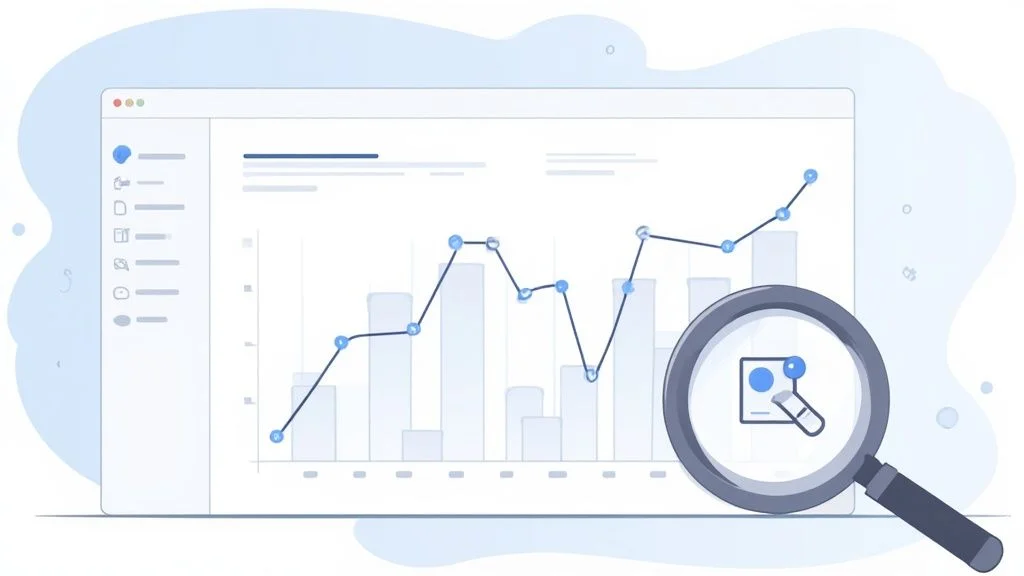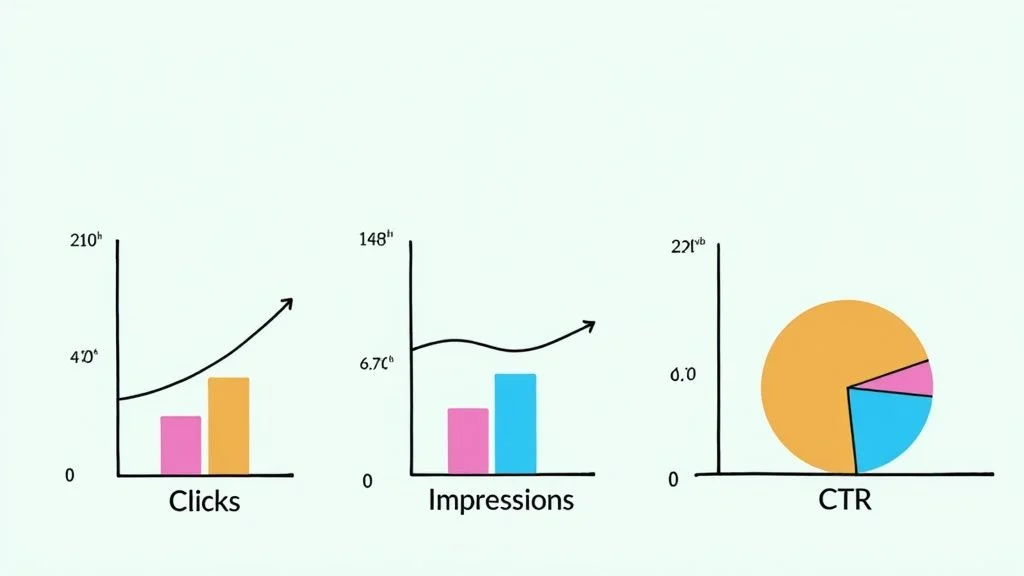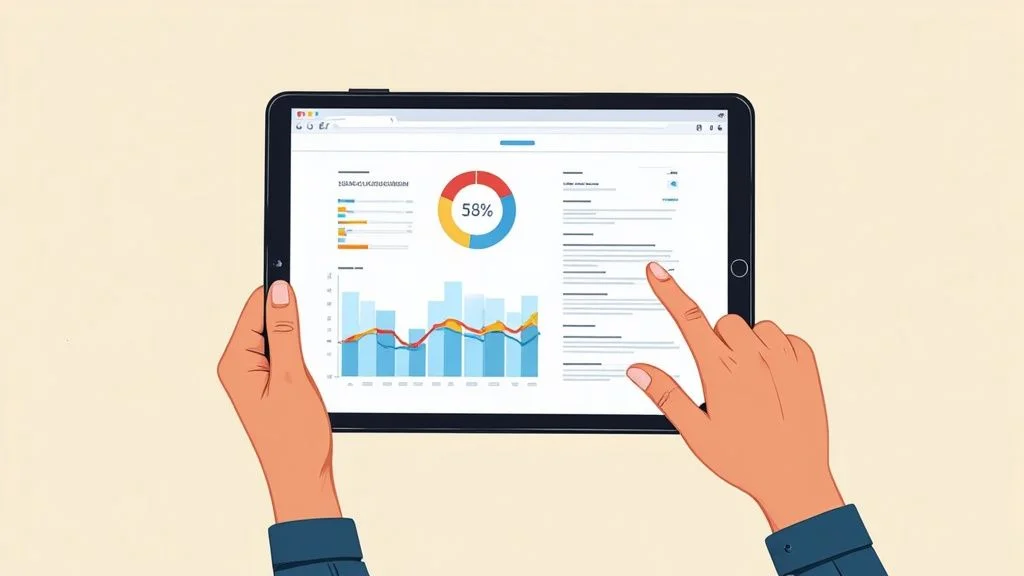
Unlock the Power of Search Console Insights for Better SEO
Sections
Image
Think of Search Console Insights as a friendly translator. It takes all the complicated numbers from Google Search Console and Google Analytics and turns them into a simple, easy-to-read story about your content.
This isn’t just another dashboard filled with charts. It’s built specifically for content creators, bloggers, and site owners who need clear, straightforward answers.
At its heart, Search Console Insights answers two simple but critical questions: “Which of my articles are people loving the most?” and “How are they finding my stuff on Google?”
By blending search data with on-site behavior, it bridges the gap between a user’s search and their experience on your page. This means you can finally see the whole picture in one spot.
#From Beta to Fully Integrated
Search Console Insights has evolved from a standalone experiment into a core feature. As of June 30, 2025, Google officially retired the old beta version and integrated a new, more powerful report directly into the main Search Console interface.
This move was a huge win for creators. It streamlined everything, making it faster to see which pages are getting clicks, what search terms are trending, and how your performance stacks up against previous periods - all without having to be a data wizard. You can read the full rundown in Google’s official announcement about the new Search Console Insights report.
#What You See on the Dashboard
The first thing you’ll notice is how clean and visual the layout is. It’s designed to give you a quick health check on your site’s performance over the last 28 days.

Right away, you get a snapshot of your site’s most important metrics: total page views and average view duration. No digging required.
The real beauty here is its focus on content-centric data. The dashboard is built to help you make smarter decisions about what to write next, which articles to update, and what content to promote.
Instead of juggling two different tools, you get one unified view. The key benefits are:
-
A Complete Story: See search performance (clicks, impressions) alongside user engagement (page views, time on page).
-
Simple, Actionable Data: Instantly spot your most popular posts and the search queries that brought people there.
-
No More Tool-Hopping: Forget switching between tabs. Get the insights you need to understand your content’s full journey in one place.
To break it down even further, here’s a quick summary of what the tool offers and why it’s so useful.
#Key Features at a Glance
| Feature | What It Tells You | Why It Matters for Creators |
|---|---|---|
| **Site Overview** | A **28-day** summary of page views and average view duration. | Gives you a quick, high-level pulse check on your content's health. |
| **Your New Content** | Performance of pages published in the last **28 days**. | Helps you see if your newest articles are resonating with your audience. |
| **Your Most Popular Content** | A list of your top-performing pages and their key stats. | Shows you what's working so you can create more of what your audience loves. |
| **How People Find You** | The top search queries driving traffic to your site. | Uncovers the exact phrases people use to find you, giving you new content ideas. |
| **Referring Links** | Links from other websites that send traffic to your pages. | Identifies which sites are your biggest fans and potential collaboration partners. |
This blend of features makes Search Console Insights an incredibly practical tool, giving you just the data you need to grow your audience.
#Unlocking Your Full Data Story

To really get the full picture of your content’s journey, you have to connect the dots. The true magic of Search Console Insights happens when it starts pulling data from two different, but equally powerful, sources.
Think of it like trying to understand a movie. Google Search Console gives you the first act - how people find your website on Google. Then, Google Analytics gives you the second act - what they actually do once they get there. Linking them together is what finally lets you see the whole story, from start to finish.
The real breakthrough comes when you associate Search Console with Analytics. It’s the key that transforms two separate sets of data into a single, cohesive narrative about your content’s performance, from the initial search to the final click.
This connection allows Search Console Insights to tell you not just which pages are getting traffic, but why they’re resonating with visitors, blending raw search performance with crucial user behavior metrics.
#The Simple Association Process
Getting these two powerhouses to talk to each other is surprisingly simple. Google made this process incredibly straightforward, so you don’t need a technical background to get it done.
The only real requirement is that you use the same Google account for both your Search Console and Google Analytics properties. That’s it.
Once you’ve got that sorted, the connection is often automatic. But if you need to set it up manually, the steps are a breeze:
-
Open Search Console Insights: Just head to the main dashboard.
-
Look for the prompt: The tool is pretty smart and will usually ask you to link an Analytics property if it detects one isn’t connected.
-
Choose your property: You’ll see a dropdown menu with all the Google Analytics properties tied to your account. Just pick the one that matches your website.
After they’re linked, the dashboard will light up with combined data, giving you a much richer, more complete view of how your content is doing. For a deeper look at the main platform’s features, check out our detailed guide on how to use Google Search Console.
#Troubleshooting Common Connection Hurdles
Sometimes, things don’t go perfectly on the first try. Don’t worry, it happens, and the fixes are usually easy.
The most common snag is a permission mismatch. You might be an “owner” in Search Console but only have “viewer” access in Analytics, which can block the connection. Make sure your account has sufficient permissions in both tools.
Another classic issue is a simple property mismatch. Double-check that the website URL in Search Console (like https://yourdomain.com) is an exact match for the property in Google Analytics. Even a tiny difference, like “http” instead of “https”, can cause it to fail. Taking care of these small details will get you up and running in no time.
#How to Read Your Insights Dashboard

Alright, you’ve got your accounts connected. Now, let’s open up the dashboard. Think of your Search Console Insights dashboard less like a spreadsheet and more like a conversation with your audience. The whole interface is built around a series of “cards,” each one telling a small part of your content’s story. It’s designed to be visual and, honestly, pretty easy to get the hang of.
The beauty here is its simplicity. It cuts through the noise of dense analytics. Right at the top, you get a quick health check of your site’s performance over the last 28 days - total page views and the average time people are sticking around. It’s your website’s pulse, right at a glance.
Below that is where the magic happens. You’ll find cards that answer the big questions: What’s working? What’s new and getting attention? How did people even find me in the first place? This is where the data starts telling a story.
#Your Main Content Cards
The first cards you’ll see are all about your content’s immediate success. Forget boring lists of URLs; these are signposts pointing directly to what your audience actually cares about.
-
Your Most Popular Content: This is your greatest hits album. It shows you which pages are pulling in the most eyeballs, making it dead simple to spot your star performers. Use this to double down on the topics and formats your audience loves.
-
Your New Content: This little gem tracks anything you’ve published in the last 28 days. It’s the perfect way to see if your latest blog post is taking off or if it needs a little nudge to get some momentum.
Think of these cards as direct, unfiltered feedback. A brand-new post getting a ton of traffic is a huge green light to create more on that exact topic. A once-popular page that’s fading might just need a quick refresh.
This is how you move from guessing what works to knowing. For example, if your article on “beginner SEO tips” is always in your top content, that’s a massive clue. It’s time to build out a whole series around that theme. This is how Search Console Insights can start guiding your entire content strategy.
#How People Find You
The next set of cards is all about the journey. They peel back the curtain on how someone goes from a random Google search to landing on your website, giving you incredible clues about what they were looking for.
This section is dominated by Google Search, and it’s home to two of the most actionable cards on the entire dashboard:
-
Top search queries: These are the exact words and phrases people typed into Google right before they clicked on your site. This list is a goldmine. It’s a direct look into your audience’s brain, showing you the language they use and the problems they need to solve.
-
Referring links from other websites: This card shows you which other sites are sending traffic your way. It’s a fantastic tool for spotting potential partners for collaboration or just seeing where your content is making waves online.
Don’t get discouraged if you see a query with tons of impressions but hardly any clicks. That’s not a failure; it’s a massive opportunity staring you in the face. It means people are seeing your content in the search results, but your headline or description isn’t grabbing their attention. A few small tweaks there could unlock a flood of new traffic.
#Turning Data Into a Content Creation Engine

Data is only valuable when you act on it. Think of your Search Console Insights dashboard as more than just a report; it’s a powerful engine for your content strategy, pointing you directly toward what your audience wants to read next. Without a plan, these insights are just numbers on a screen.
It’s like having a personal brainstorming partner. Instead of just guessing what topics might work, you can use real data to build a smarter, more effective content calendar. This simple shift moves your strategy from being reactive to proactive, making sure every article you create already has a built-in audience waiting for it.
#Find Your Next Big Article Idea
The “Trending queries” card is your secret weapon here. It’s where you’ll uncover fresh content ideas that are already gaining momentum with your audience. These aren’t just random keywords; they are the exact questions and topics people are searching for right now. When a query starts to spike, that’s your cue to jump on it.
Your “Most popular content” card is just as important. It reveals your winning formula. Look for patterns in the articles that are already performing well.
-
What are the topics? Are there recurring themes that always seem to draw a crowd?
-
What are the formats? Do your “how-to” guides consistently outperform listicles? Or are case studies getting all the love?
-
What’s the tone? Is your audience responding better to a casual, conversational voice or a more formal, authoritative one?
By dissecting what’s already working, you can replicate that success. This is how you stop throwing content at the wall to see what sticks and start building a library of high-performers. If you want to dig deeper into how search engines rank this content, it helps to start by understanding Google’s search algorithm updates.
The actionable nature of this data is its biggest strength. It’s not just about looking at numbers; it’s about turning those numbers into a repeatable process for growth.
And this isn’t just theory. Acting on these insights has a measurable impact. For example, by applying best practices from Search Console, India’s MX Player, a major video streaming service, successfully tripled its website traffic. They also saw a 100% increase in video pageviews per session. These figures show the direct link between using search data and hitting major business goals.
#Conduct a Quick Content Audit
Finally, use Search Console Insights to run quick and effective content audits. Scan your “Most popular content” list for hidden gems - those articles that are still getting steady traffic but haven’t been touched in a while. These are your prime candidates for a refresh.
Updating these older posts with new information, better visuals, or more internal links can give them a serious boost in the search rankings. It’s a simple strategy that leverages the assets you already have to capture even more organic traffic, all without having to start from scratch.
#Pro-Level Strategies for Deeper Insights
Alright, once you’ve gotten the hang of the basic dashboard, it’s time to unlock the real strategic power of Search Console Insights. While it’s fantastic for a quick check-in, the real pros know its data becomes exponentially more valuable when you start mixing it with other resources. This is how you shift from just watching your performance to actively shaping it.
Think of the data in Search Console Insights as high-quality ingredients. They’re good on their own, sure. But when you combine them with other tools and techniques, you can cook up a much more sophisticated - and effective - strategy. This is where you graduate from being a reactive content creator to a predictive SEO strategist.
#Find Untapped Keyword Opportunities
One of the most powerful moves you can make is using your top-performing queries as a launchpad for deeper keyword research. The “Most Searched Queries” card is a goldmine; it tells you exactly what you already rank for. But what about all the related terms you’re missing out on?
Simply export your list of top queries and plug them into a dedicated keyword research tool. This one simple step can uncover a treasure trove of untapped long-tail keywords - those super-specific, less competitive phrases that your audience is actively searching for. For instance, if “best coffee grinder” is a top query for you, a deeper dive might unearth gems like “best burr grinder for espresso” or “quietest coffee grinder for apartments.” Grabbing these allows you to capture highly targeted traffic that your competitors are probably ignoring.
#Monitor Performance After Big Changes
Are you getting ready for a big site redesign? Planning a major content overhaul or shifting your internal linking strategy? Search Console Insights is the perfect tool to keep an eye on the impact of these changes. It gives you a crystal-clear, high-level “before and after” snapshot of your content’s performance.
Use the dashboard as your performance benchmark. By tracking clicks, impressions, and top pages before and after a significant update, you get direct feedback on whether your changes are helping or hurting your visibility. This turns gut feelings into data-backed decisions.
Let’s say you just launched a new series of video-focused articles. You can pop into Insights to see if those new pages are starting to show up in your “Most Popular Content” list. It’s a beautifully straightforward way to confirm if your strategic bets are paying off and actually driving the traffic you hoped for.
This approach gives you a simple yet powerful way to measure the ROI of your efforts, making sure every change you make moves you closer to your goals. You can learn more about how to structure these connections effectively in our guide to building a robust internal linking strategy.
#Answering Your Top Questions
As you start playing around with the interface, a few questions will almost certainly pop up. It’s totally normal to wonder about why data looks a certain way or how this new tool fits in with the ones you’ve been using for years. Let’s clear up some of the most common head-scratchers so you can use Search Console Insights with complete confidence.
Think of this as your quick-reference guide. It’s here to smooth out any little wrinkles in your understanding as you get going.
#What’s the Real Difference Between Search Console Insights and Google Analytics?
This is the big one, the question we hear all the time. A simple analogy makes it crystal clear.
Imagine your website is a house. Google Analytics tells you absolutely everything that happens inside your house. It tracks which rooms people visit, how long they hang out, and which doors they use to leave. It covers every single visitor, no matter how they got there.
Search Console Insights, on the other hand, tells you the specific story of how people found your house from the street (that’s Google Search) and which of your front doors (your content) looked the most appealing. It connects the dots from search to engagement, helping you build more popular “front doors.”
#Why Doesn’t My Data Match Google Analytics Perfectly?
Don’t panic! It’s perfectly normal for the numbers in Search Console Insights and Google Analytics to be slightly different. It doesn’t mean anything is broken. The two tools are simply measuring related, but different, things.
-
Clicks vs. Sessions: Search Console Insights tracks clicks that come directly from Google’s search results. Google Analytics tracks sessions (or visits) from all sources - social media, email campaigns, people typing your URL directly, you name it. A single user can easily create multiple sessions.
-
Data Processing: The tools also process and refresh their data on different schedules. A small time lag between them is completely expected.
The key is to see them as two different tools for two different jobs. Use Search Console Insights for quick, directional feedback on how your content is doing in search. Use Google Analytics when you need to do a deep, comprehensive dive into all user behavior on your site.
#How Often Should I Really Check It?
Honestly, this depends entirely on how often you’re publishing new content. There’s no magic number, but here’s a good rule of thumb to get you started:
-
If you publish frequently (several times a week): A weekly check-in is perfect. It’s just enough time to spot early trends, see how your newest articles are landing, and find fresh ideas from trending search queries.
-
If you publish less often (once or twice a month): Popping in every two weeks or once a month is more than enough. This rhythm is great for keeping an eye on your evergreen content and catching any big shifts in performance.
The most important thing is consistency. Making this a regular part of your routine is how you’ll squeeze the most value out of the tool over the long run.
#Can I Use It Without Google Analytics?
Technically, yes, you can. But you’d be missing a huge piece of the puzzle. It’s like watching a movie with the sound turned off - you can still follow the basic plot, but you’re missing all the important context and nuance.
Without linking a Google Analytics property, you’ll still get all the data from Google Search Console. That includes your clicks, impressions, top search queries, and most popular pages from Google Search.
But you won’t see the crucial engagement metrics that Analytics provides, like total page views (from all traffic sources) and the average time people spend on your page. To get the rich, integrated story that Search Console Insights was designed to tell, connecting both is the way to go. It truly unlocks the tool’s full potential.
At Rankdigger, we’re committed to turning complex data into clear actions. Our all-in-one SEO platform is designed to give you the practical insights and intuitive tools you need to grow your organic visibility. Explore our features and guides at https://rankdigger.com/en.

